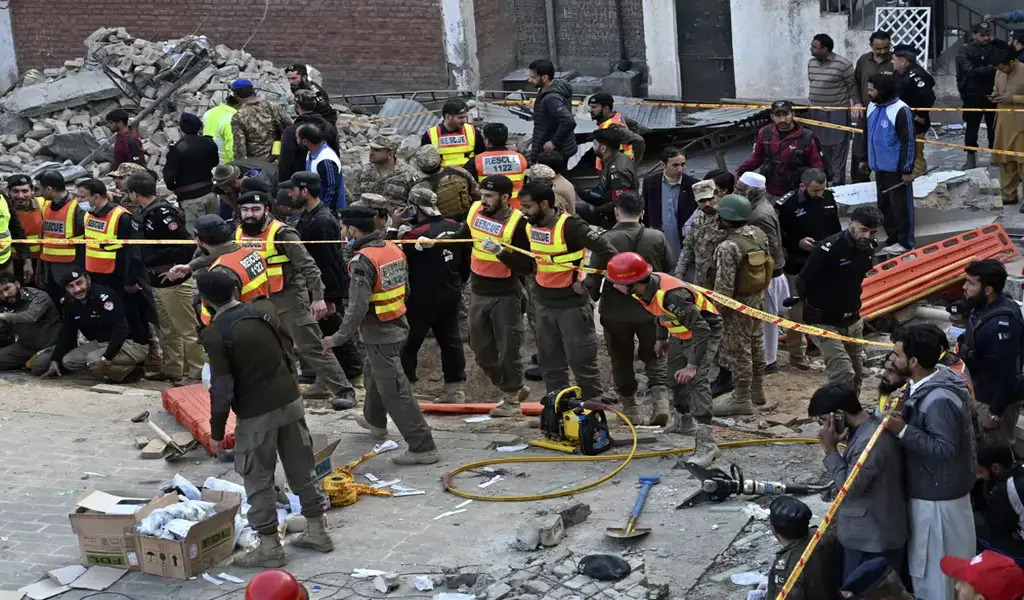News
Pakistan Mosque Suicide Bombing Death Toll Reaches 93
(CTN NEWS) – PESHAWAR – Officials said that 93 people had died due to a suicide explosion at a mosque in northwest Pakistan on Tuesday.
One of the bloodiest strikes on Pakistani security forces in recent years was the assault on a Sunni mosque within a significant police complex.
When the bomber detonated his explosives vest on Monday morning, there were around 300 worshippers worshipping in the mosque in Peshawar and more were on their way.
The explosion tore through the mosque, killing dozens of people, wounding many more, and blowing off a portion of the roof.

Security officials and rescue workers search bodies at the site of suicide bombing, in Peshawar, Pakistan, Monday, Jan. 30, 2023. (AP Photo/Zubair Khan)
After that, what was left of the roof collapsed, hurting many more people, according to police officer Zafar Khan. To reach worshippers trapped beneath the rubble, rescuers had to clear mountains of debris.
According to Mohammad Asim, a government hospital spokesman in Peshawar, more bodies were found overnight and early on Tuesday, and several critically injured died.
Of the victims, Asim noted that “most of them were cops.”
The main rescue official, Bilal Faizi, stated that rescue crews were still at the scene on Tuesday because additional individuals were reportedly stuck inside.
At various cemeteries in the city and elsewhere, mourners were burying the victims. More than 150 people were also injured in the bombing.

In this handout photo released by Pakistan’s Police Department, security officials gather for funeral prayers of police officer, who were killed in the suicide bombing inside a mosque, in Peshawar, Pakistan, Monday, Jan. 30, 2023.(Pakistan’s Police Department via AP)
Uncertainty about how the bomber entered the walled compound, located in a high-security area with other government buildings, and made it to the mosque is a sign of a significant security breakdown.
The provincial governor of Khyber Pakhtunkhwa province, whose capital city is Peshawar, Ghulam Ali, stated that the probe will demonstrate “how the terrorist entered the mosque.”
“Yes, a security breach occurred,” he continued.
After the incident, Prime Minister Shahbaz Sharif went to a hospital in Peshawar and promised “severe punishment” against those responsible.
“The human tragedy’s sheer scope is unfathomable. This constitutes an attack on Pakistan, he tweeted. He sent his sympathies to the victim’s families, stating that their suffering “cannot be articulated in words.”

In this handout photo released by Press Information Department, Pakistan’s Prime Minister Shehbaz Sharif, second left, and Army Chief, Gen. Asim Munir, comfort an injured victim of a suicide bombing inside a mosque during their visit to hospital, in Peshawar, Pakistan, Monday, Jan. 30, 2023. (Press Information Department via AP)
Who was responsible for the blast is still unknown to the authorities. Tehreek-e-Taliban Pakistan, often known as the Pakistani Taliban or Sarbakaf Mohmand, claimed responsibility for the attack in a tweet shortly after the blast.
Hours later, however, TTP spokesman Mohammad Khurasani dissociated the group from the attack, claiming that it was against TTP doctrine to target mosques, seminaries, and other places of worship.
He further warned that anybody who engaged in such behavior could face retaliation. He said nothing about the reason a TTP commander had taken credit for the bombing.
Since the Pakistani Taliban broke their cease-fire with government forces in November, attacks by militants have increased in Pakistan’s predominantly Sunni Muslim nation.
The Pakistani Taliban claimed earlier this month that one of its members had shot and murdered two intelligence agents, including the head of the nation’s military-based spy agency Inter-Services Intelligence’s counterterrorism division.

Security officials and rescue workers gather at the site of a suicide bombing inside a mosque in Peshawar, Pakistan, Monday, Jan. 30, 2023.(AP Photo/Zubair Khan)
Security officials reported on Monday that the shooter was located and killed in a battle near the Afghan border in the northwest.
The Afghan Taliban and the TTP are independent but close allies.
For the past 15 years, it has waged an insurgency in Pakistan, calling for the stronger application of Islamic law, the release of its members who the government detains.
And a decrease in the military presence of Pakistan in the Khyber Pakhtunkhwa region, which it has long utilised as a base.
The main insurgent organization in the province is the Pakistani Taliban, and Peshawar has frequently been the target of strikes.

People wait for transport next to a coffin of their relative, killed in the suicide bombing inside a mosque, after collecting from a hospital, in Peshawar, Pakistan, Monday, Jan. 30, 2023. (AP Photo/Muhammad Sajjad)
A Pakistani Taliban branch killed 154 people, mostly pupils, in an attack on an army-run school in Peshawar in 2014.
In recent years, Pakistan has also been the target of deadly strikes by the Islamic State group’s regional offshoot.
Since the Afghan Taliban took control of the neighboring nation in August 2021 and U.S. and NATO soldiers left the country after 20 years of conflict, violence has grown.
The cease-fire between the Pakistani government and the TTP expired as the nation was still dealing with the effects of the country’s record-breaking flooding last summer.
Which claimed 1,739 lives, wrecked more than 2 million homes, and at one point flooded as much as a third of it.

(AP Photo/Shakil Adil, file)
The Afghan Foreign Ministry, controlled by the Taliban, expressed its “sadness to learn that countless people lost their lives” in Peshawar and denounced attacks on worshippers as being against Islamic tenets.
U.S. Secretary of State Antony Blinken expressed his sympathies and described the Peshawar explosion as a “horrific attack” while visiting the Middle East.
He declared that “terrorism for any purpose, anywhere, is inexcusable.”
Worshipers at a mosque in Peshawar endured a horrific attack today, which killed and injured many. Terrorism for any reason at any place is indefensible. I extend my deepest condolences to the families and loved ones of the victims. https://t.co/bPvvcKdwfN
— Secretary Antony Blinken (@SecBlinken) January 30, 2023
The Saudi and American embassies in Islamabad expressed their condemnation, with the American embassy stating that “the United States stands with Pakistan in denouncing all forms of terrorism.”
According to U.N. spokesman Stephane Dujarric, Secretary-General Antonio Guterres referred to the attack as “especially heinous” because it targeted a house of worship.

Security officials and rescue workers gather at the site of suicide bombing, in Peshawar, Pakistan, Monday, Jan. 30, 2023. (AP Photo/Zubair Khan)
Cash-strapped Pakistan is amid a dire economic crisis and has to borrow $1.1 billion from the IMF as part of a $6 billion bailout package to stay out of debt. In recent months, negotiations to revive the bailout have stalled with the IMF.
Imran Khan, a former prime minister of Pakistan, also sent his condolences and described the blast as a “terrorist suicide act.”
Khan was overthrown in a no-confidence vote in Parliament in April, ushering in Sharif’s administration.
Since then, Khan has advocated for early elections, claiming that his removal was unlawful and resulted from a plan supported by the United States. Washington and Sharif reject Khan’s assertions.
RELATED CTN NEWS:
RELATED CTN NEWS:
Former Police Officer Charged With Trafficking 170kg of Methamphetamine

News
Trudeau’s Gun Grab Could Cost Taxpayers a Whopping $7 Billion

A recent report indicates that since Trudeau’s announcement of his gun buyback program four years ago, almost none of the banned firearms have been surrendered.
The federal government plans to purchase 2,063 firearm models from retailers following the enactment of Bill C-21, which amends various Acts and introduces certain consequential changes related to firearms. It was granted royal assent on December 15 of last year.
This ban immediately criminalized the actions of federally-licensed firearms owners regarding the purchase, sale, transportation, importation, exportation, or use of hundreds of thousands of rifles and shotguns that were previously legal.
The gun ban focused on what it termed ‘assault-style weapons,’ which are, in reality, traditional semi-automatic rifles and shotguns that have enjoyed popularity among hunters and sport shooters for over a century.
In May 2020, the federal government enacted an Order-in-Council that prohibited 1,500 types of “assault-style” firearms and outlined specific components of the newly banned firearms. Property owners must adhere to the law by October 2023.
Trudeau’s Buyback Hasn’t Happened
“In the announcement regarding the ban, the prime minister stated that the government would seize the prohibited firearms, assuring that their lawful owners would be ‘grandfathered’ or compensated fairly.” “That hasn’t happened,” criminologist Gary Mauser told Rebel News.
Mauser projected expenses ranging from $2.6 billion to $6.7 billion. The figure reflects the compensation costs amounting to $756 million, as outlined by the Parliamentary Budget Office (PBO).
“The projected expenses for gathering the illegal firearms are estimated to range from $1.6 billion to $7 billion.” “This range estimate increases to between $2.647 billion and $7 billion when compensation costs to owners are factored in,” Mauser stated.
Figures requested by Conservative MP Shannon Stubbs concerning firearms prohibited due to the May 1, 2020 Order In Council reveal that $72 million has been allocated to the firearm “buyback” program, yet not a single firearm has been confiscated to date.
In a recent revelation, Public Safety Canada disclosed that the federal government allocated a staggering $41,094,556, as prompted by an order paper question from Conservative Senator Don Plett last September, yet yielded no tangible outcomes.
An internal memo from late 2019 revealed that the Liberals projected their politically motivated harassment would incur a cost of $1.8 billion.
Enforcement efforts Questioned
By December 2023, estimates from TheGunBlog.ca indicate that the Liberals and RCMP had incurred or were responsible for approximately $30 million in personnel expenses related to the enforcement efforts. The union representing the police service previously stated that the effort to confiscate firearms is a “misdirected effort” aimed at ensuring public safety.
“This action diverts crucial personnel, resources, and funding from tackling the more pressing and escalating issue of criminal use of illegal firearms,” stated the National Police Federation (NPF).
The Canadian Sporting Arms & Ammunition Association (CSAAA), representing firearms retailers, has stated it will have “zero involvement” in the confiscation of these firearms. Even Canada Post held back from providing assistance due to safety concerns.
The consultant previously assessed that retailers are sitting on almost $1 billion worth of inventory that cannot be sold or returned to suppliers because of the Order-In-Council.
“Despite the ongoing confusion surrounding the ban, after four years, we ought to be able to address one crucial question.” Has the prohibition enhanced safety for Canadians? Mauser asks.
Illegally Obtained Firearms are the Problem
Statistics Canada reports a 10% increase in firearm-related violent crime between 2020 and 2022, rising from 12,614 incidents to 13,937 incidents. In that timeframe, the incidence of firearm-related violent crime increased from 33.7 incidents per 100,000 population in 2021 to 36.7 incidents the subsequent year.
“This marks the highest rate documented since the collection of comparable data began in 2009,” the criminologist explains.
Supplementary DataData indicates that firearm homicides have risen since 2020. “The issue lies not with lawfully-held firearms,” Mauser stated.
Firearms that have been banned under the Order-in-Council continue to be securely stored in the safes of their lawful owners. The individuals underwent a thorough vetting process by the RCMP and are subject to nightly monitoring to ensure there are no infractions that could pose a risk to public safety.
“The firearms involved in homicides were seldom legally owned weapons wielded by their rightful owners,” Mauser continues. The number of offenses linked to organized crime has surged from 4,810 in 2016 to a staggering 13,056 in 2020.
“If those in power … aim to diminish crime and enhance public safety, they ought to implement strategies that effectively focus on offenders and utilize our limited tax resources judiciously to reach these objectives,” he stated.
Related News:
Millennials in Canada Have Turned their Backs on Justin Trudeau
Millennials in Canada Have Turned their Backs on Justin Trudeau
News
Google’s Search Dominance Is Unwinding, But Still Accounting 48% Search Revenue

Google is so closely associated with its key product that its name is a verb that signifies “search.” However, Google’s dominance in that sector is dwindling.
According to eMarketer, Google will lose control of the US search industry for the first time in decades next year.
Google will remain the dominant search player, accounting for 48% of American search advertising revenue. And, remarkably, Google is still increasing its sales in the field, despite being the dominating player in search since the early days of the George W. Bush administration. However, Amazon is growing at a quicker rate.
Google’s Search Dominance Is Unwinding
Amazon will hold over a quarter of US search ad dollars next year, rising to 27% by 2026, while Google will fall even more, according to eMarketer.
The Wall Street Journal was first to report on the forecast.
Lest you think you’ll have to switch to Bing or Yahoo, this isn’t the end of Google or anything really near.
Google is the fourth-most valued public firm in the world. Its market worth is $2.1 trillion, trailing just Apple, Microsoft, and the AI chip darling Nvidia. It also maintains its dominance in other industries, such as display advertisements, where it dominates alongside Facebook’s parent firm Meta, and video ads on YouTube.
To put those “other” firms in context, each is worth more than Delta Air Lines’ total market value. So, yeah, Google is not going anywhere.
Nonetheless, Google faces numerous dangers to its operations, particularly from antitrust regulators.
On Monday, a federal judge in San Francisco ruled that Google must open up its Google Play Store to competitors, dealing a significant blow to the firm in its long-running battle with Fortnite creator Epic Games. Google announced that it would appeal the verdict.
In August, a federal judge ruled that Google has an illegal monopoly on search. That verdict could lead to the dissolution of the company’s search operation. Another antitrust lawsuit filed last month accuses Google of abusing its dominance in the online advertising business.
Meanwhile, European regulators have compelled Google to follow tough new standards, which have resulted in multiple $1 billion-plus fines.

Pixa Bay
Google’s Search Dominance Is Unwinding
On top of that, the marketplace is becoming more difficult on its own.
TikTok, the fastest-growing social network, is expanding into the search market. And Amazon has accomplished something few other digital titans have done to date: it has established a habit.
When you want to buy anything, you usually go to Amazon, not Google. Amazon then buys adverts to push companies’ products to the top of your search results, increasing sales and earning Amazon a greater portion of the revenue. According to eMarketer, it is expected to generate $27.8 billion in search revenue in the United States next year, trailing only Google’s $62.9 billion total.
And then there’s AI, the technology that (supposedly) will change everything.
Why search in stilted language for “kendall jenner why bad bunny breakup” or “police moving violation driver rights no stop sign” when you can just ask OpenAI’s ChatGPT, “What’s going on with Kendall Jenner and Bad Bunny?” in “I need help fighting a moving violation involving a stop sign that wasn’t visible.” Google is working on exactly this technology with its Gemini product, but its success is far from guaranteed, especially with Apple collaborating with OpenAI and other businesses rapidly joining the market.
A Google spokeswoman referred to a blog post from last week in which the company unveiled ads in its AI overviews (the AI-generated text that appears at the top of search results). It’s Google’s way of expressing its ability to profit on a changing marketplace while retaining its business, even as its consumers steadily transition to ask-and-answer AI and away from search.

Google has long used a single catchphrase to defend itself against opponents who claim it is a monopoly abusing its power: competition is only a click away. Until recently, that seemed comically obtuse. Really? We are going to switch to Bing? Or Duck Duck Go? Give me a break.
But today, it feels more like reality.
Google is in no danger of disappearing. However, every highly dominating company faces some type of reckoning over time. GE, a Dow mainstay for more than a century, was broken up last year and is now a shell of its previous dominance. Sears declared bankruptcy in 2022 and is virtually out of business. US Steel, long the foundation of American manufacturing, is attempting to sell itself to a Japanese corporation.
SOURCE | CNN
News
The Supreme Court Turns Down Biden’s Government Appeal in a Texas Emergency Abortion Matter.

(VOR News) – A ruling that prohibits emergency abortions that contravene the Supreme Court law in the state of Texas, which has one of the most stringent abortion restrictions in the country, has been upheld by the Supreme Court of the United States. The United States Supreme Court upheld this decision.
The justices did not provide any specifics regarding the underlying reasons for their decision to uphold an order from a lower court that declared hospitals cannot be legally obligated to administer abortions if doing so would violate the law in the state of Texas.
Institutions are not required to perform abortions, as stipulated in the decree. The common populace did not investigate any opposing viewpoints. The decision was made just weeks before a presidential election that brought abortion to the forefront of the political agenda.
This decision follows the 2022 Supreme Court ruling that ended abortion nationwide.
In response to a request from the administration of Vice President Joe Biden to overturn the lower court’s decision, the justices expressed their disapproval.
The government contends that hospitals are obligated to perform abortions in compliance with federal legislation when the health or life of an expectant patient is in an exceedingly precarious condition.
This is the case in regions where the procedure is prohibited. The difficulty hospitals in Texas and other states are experiencing in determining whether or not routine care could be in violation of stringent state laws that prohibit abortion has resulted in an increase in the number of complaints concerning pregnant women who are experiencing medical distress being turned away from emergency rooms.
The administration cited the Supreme Court’s ruling in a case that bore a striking resemblance to the one that was presented to it in Idaho at the beginning of the year. The justices took a limited decision in that case to allow the continuation of emergency abortions without interruption while a lawsuit was still being heard.
In contrast, Texas has been a vocal proponent of the injunction’s continued enforcement. Texas has argued that its circumstances are distinct from those of Idaho, as the state does have an exemption for situations that pose a significant hazard to the health of an expectant patient.
According to the state, the discrepancy is the result of this exemption. The state of Idaho had a provision that safeguarded a woman’s life when the issue was first broached; however, it did not include protection for her health.
Certified medical practitioners are not obligated to wait until a woman’s life is in imminent peril before they are legally permitted to perform an abortion, as determined by the state supreme court.
The state of Texas highlighted this to the Supreme Court.
Nevertheless, medical professionals have criticized the Texas statute as being perilously ambiguous, and a medical board has declined to provide a list of all the disorders that are eligible for an exception. Furthermore, the statute has been criticized for its hazardous ambiguity.
For an extended period, termination of pregnancies has been a standard procedure in medical treatment for individuals who have been experiencing significant issues. It is implemented in this manner to prevent catastrophic outcomes, such as sepsis, organ failure, and other severe scenarios.
Nevertheless, medical professionals and hospitals in Texas and other states with strict abortion laws have noted that it is uncertain whether or not these terminations could be in violation of abortion prohibitions that include the possibility of a prison sentence. This is the case in regions where abortion prohibitions are exceedingly restrictive.
Following the Supreme Court’s decision to overturn Roe v. Wade, which resulted in restrictions on the rights of women to have abortions in several Republican-ruled states, the Texas case was revisited in 2022.
As per the orders that were disclosed by the administration of Vice President Joe Biden, hospitals are still required to provide abortions in cases that are classified as dire emergency.
As stipulated in a piece of health care legislation, the majority of hospitals are obligated to provide medical assistance to patients who are experiencing medical distress. This is in accordance with the law.
The state of Texas maintained that hospitals should not be obligated to provide abortions throughout the litigation, as doing so would violate the state’s constitutional prohibition on abortions. In its January judgment, the 5th United States Circuit Court of Appeals concurred with the state and acknowledged that the administration had exceeded its authority.
SOURCE: AP
SEE ALSO:
Could Last-Minute Surprises Derail Kamala Harris’ Campaign? “Nostradamus” Explains the US Poll.
-

 News3 years ago
News3 years agoLet’s Know About Ultra High Net Worth Individual
-
Entertainment2 years ago
Mabelle Prior: The Voice of Hope, Resilience, and Diversity Inspiring Generations
-

 Health4 years ago
Health4 years agoHow Much Ivermectin Should You Take?
-

 Tech2 years ago
Tech2 years agoTop Forex Brokers of 2023: Reviews and Analysis for Successful Trading
-

 Lifestyles3 years ago
Lifestyles3 years agoAries Soulmate Signs
-

 Movies2 years ago
Movies2 years agoWhat Should I Do If Disney Plus Keeps Logging Me Out of TV?
-

 Health3 years ago
Health3 years agoCan I Buy Ivermectin Without A Prescription in the USA?
-

 Learning3 years ago
Learning3 years agoVirtual Numbers: What Are They For?
